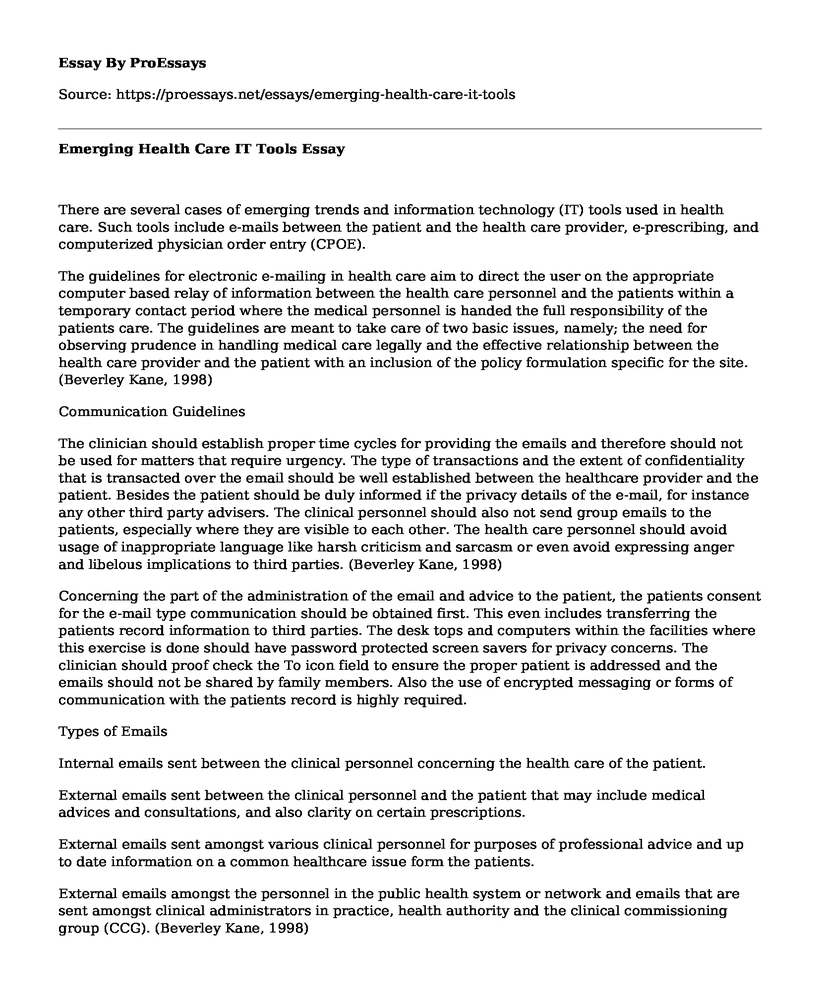There are several cases of emerging trends and information technology (IT) tools used in health care. Such tools include e-mails between the patient and the health care provider, e-prescribing, and computerized physician order entry (CPOE).
The guidelines for electronic e-mailing in health care aim to direct the user on the appropriate computer based relay of information between the health care personnel and the patients within a temporary contact period where the medical personnel is handed the full responsibility of the patients care. The guidelines are meant to take care of two basic issues, namely; the need for observing prudence in handling medical care legally and the effective relationship between the health care provider and the patient with an inclusion of the policy formulation specific for the site. (Beverley Kane, 1998)
Communication Guidelines
The clinician should establish proper time cycles for providing the emails and therefore should not be used for matters that require urgency. The type of transactions and the extent of confidentiality that is transacted over the email should be well established between the healthcare provider and the patient. Besides the patient should be duly informed if the privacy details of the e-mail, for instance any other third party advisers. The clinical personnel should also not send group emails to the patients, especially where they are visible to each other. The health care personnel should avoid usage of inappropriate language like harsh criticism and sarcasm or even avoid expressing anger and libelous implications to third parties. (Beverley Kane, 1998)
Concerning the part of the administration of the email and advice to the patient, the patients consent for the e-mail type communication should be obtained first. This even includes transferring the patients record information to third parties. The desk tops and computers within the facilities where this exercise is done should have password protected screen savers for privacy concerns. The clinician should proof check the To icon field to ensure the proper patient is addressed and the emails should not be shared by family members. Also the use of encrypted messaging or forms of communication with the patients record is highly required.
Types of Emails
Internal emails sent between the clinical personnel concerning the health care of the patient.
External emails sent between the clinical personnel and the patient that may include medical advices and consultations, and also clarity on certain prescriptions.
External emails sent amongst various clinical personnel for purposes of professional advice and up to date information on a common healthcare issue form the patients.
External emails amongst the personnel in the public health system or network and emails that are sent amongst clinical administrators in practice, health authority and the clinical commissioning group (CCG). (Beverley Kane, 1998)
Privacy Rules
The Rules of the Health Insurance Portability and Accountability Act (HIPAA) Security are put in place to ensure the enforcement of measures meant to always safeguard a patients electronic health information and to maintain its security, confidentiality and integrity. These safety measures that protect the patients medical records are incorporated into the electronic health record systems. They include; the use access control mechanisms for example, personal identification numbers and passwords to limit the access of this information to only authorized clinical personnel; and the encryption of the stored patient information. The patients encrypted information is only accessible to a clinical personnel with an authorized decryption key. ("Summary of the HIPAA Privacy Rule", 2008)
References
Beverley Kane, D. (1998). Guidelines for the Clinical Use of Electronic Mail with Patients. Journal Of The American Medical Informatics Association : JAMIA, 5(1), 104. Retrieved from http://www.ncbi.nlm.nih.gov/pmc/articles/PMC61279/
Summary of the HIPAA Privacy Rule. (2008). HHS.gov. Retrieved 24 August 2016, from http://www.hhs.gov/hipaa/for-professionals/privacy/laws-regulations/
Cite this page
Emerging Health Care IT Tools. (2021, Mar 22). Retrieved from https://proessays.net/essays/emerging-health-care-it-tools
If you are the original author of this essay and no longer wish to have it published on the ProEssays website, please click below to request its removal:
- Paper Example on Codes and Coding
- Nursing Informatics: DIKW (Data, Information, Knowledge, and Wisdom) Essay
- The Ethics of Euthanasia and Physician-Assisted Suicide Essay Example
- Essay Sample on Business Outline
- Nursing Care Philosophy Essay Example
- Essay Example on Supplements: Enhancing Exercise & Athletic Performance
- Deadliest Flu Pandemic: The Spanish Flu of 1918 - Essay Sample







